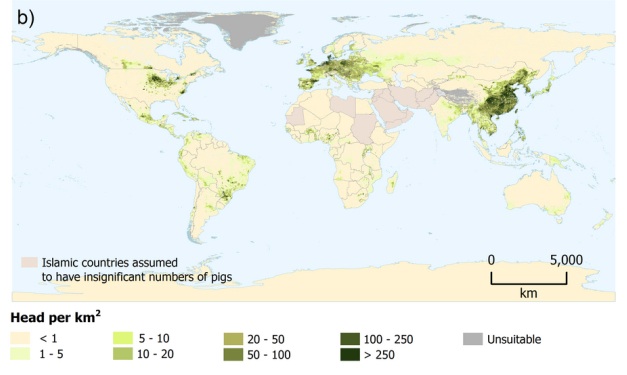
Our Weekly Roundup: From Bank Regulation to Water Taxation
November 15, 2014
The Downside of Cheap Oil
November 17, 2014By Elizabeth Fournier (recently interviewed by Bloomberg for her work with pig advocacy) with Elaine Schwartz
Below is a “pig map,” which shows the density of pigs in the world. You can see the dark green in Europe and the United States, which represents over 250 pigs per square kilometer. What’s the difference between the two? In the United States, pigs are confined to gestation crates.

From: From: “Mapping the Global Distribution of Livestock” by Timothy P. Robinson et al.
Where are we going? To why gestation crates are not only inhumane, but are also not economically advantageous.
Humane Treatment is Good Economics
During the three delicate months of their pregnancies, mother pigs are confined to gestation crates. These metal cages, which are usually six feet by two feet, provide these intelligent creatures with nearly no room for movement. Keep in mind that most mother pigs are bred eight times before being slaughtered, and are more intelligent than your cats and dogs at home. Although some members of the pork industry may disagree, gestation crates are both inhumane and not economically viable.
An alternative to gestation crates, “group housing,” can vary slightly depending on pen layout and group size but allows mother pigs to move and interact with each other.
Iowa State University recently completed an economic comparison between gestation crates and group housing. They tracked 353 sows, and found that “reproductive performance can be maintained or enhanced in well-managed group housing systems… without increasing labor” and that “group housing… resulted in a weaned pig cost that was 11 percent less than the cost of a weaned pig from the individual stall confinement system.”
The European Union and nine states have already outlawed the use of gestation crates. Backed by public support, a bill is currently waiting for Governor Christie’s signature in New Jersey.
Our Bottom line: Opportunity Cost
What exactly is the opportunity cost of switching to a more humane method of confinement for mother pigs and is it worth the sacrifice? Comparing individual confinement structures and group housing, the Iowa State University study concluded that group housing costs less to build, farmers had more weaned pigs at a lower total cost, and operating costs were similar for both approaches. Even if treatment of pigs isn’t your main concern, if you care about economic efficiency, you will oppose gestation crates.
![econlifelogotrademarkedwebsitelogo[1]](/wp-content/uploads/2024/05/econlifelogotrademarkedwebsitelogo1.png#100878)



